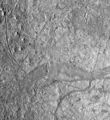File:PIA01125 Europa chaos and gray band.jpg
Jump to navigation
Jump to search

Size of this preview: 550 × 599 pixels. Other resolutions: 220 × 240 pixels | 441 × 480 pixels | 705 × 768 pixels | 940 × 1,024 pixels | 1,510 × 1,645 pixels.
Original file (1,510 × 1,645 pixels, file size: 858 KB, MIME type: image/jpeg)
File history
Click on a date/time to view the file as it appeared at that time.
| Date/Time | Thumbnail | Dimensions | User | Comment | |
|---|---|---|---|---|---|
| current | 17:26, 27 February 2011 |  | 1,510 × 1,645 (858 KB) | Bryan Derksen | Cropping off black border. I used the PNG version from the source URL as the source for this operation so it shouldn't introduce recompression artifacts. |
| 23:11, 13 March 2010 |  | 1,710 × 1,845 (680 KB) | WolfmanSF | {{Information |Description=This mosaic of part of Jupiter's moon, Europa, shows a region that is characterized by mottled (dark and splotchy) terrain. The images in this mosaic were obtained by Solid State Imaging (CCD) system on NASA's Galileo spacecraft |
File usage
The following 4 pages use this file:
Global file usage
The following other wikis use this file:
- Usage on beta.wikiversity.org

